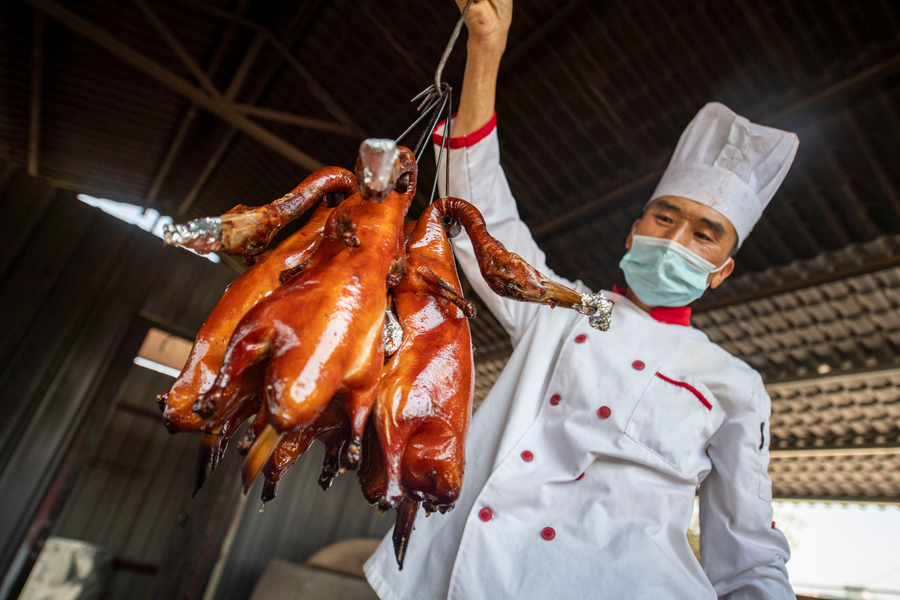Overseas athletes in food frenzy at Beijing 2022
 0 Comment(s)
0 Comment(s) Print
Print E-mail Xinhua, February 15, 2022
E-mail Xinhua, February 15, 2022

For some overseas athletes, it might be a "sweet melancholy" to compete at the Beijing Winter Games as they are struggling to keep a fine balance between maintaining their form and enjoying local delicacies.
American snowboarder Tessa Maud, a first-time Olympian, treated herself to one more big meal at the cafeteria of the athlete village on Feb. 12 before leaving Beijing for home.
The 18-year-old shared her menu on TikTok - fried rice, Kung Pao Chicken, cauliflower, green scallion pancakes and sweets and Beijing roast duck, which tasted "insane" as she described.
Maud has become an internet sensation in China after she shared a vlog in which she was moved into tears when a joyful Chinese volunteer said "Welcome to China" to her at the opening ceremony. The heartfelt moment also touched millions of netizens worldwide as well.
But more surprises were waiting.
Beijing 2022 proved to be a totally new and enjoyable culinary experience for Maud. What to eat was a daily hard choice for her because "everything is so good."
She documented details about her life in Beijing with her cafeteria diaries hailed by many viewers.
"I tried sweet and sour pork, pork dumplings, spicy tofu, and Dandan noodles. Please tell me more things to try," she asked on Tiktok, which was immediately echoed by followers making a list of popular Chinese dishes under her account.
Julia Marino, Maud's compatriot, also surprised the world after she admitted to having wolfed down around 200 dumplings during the Beijing Winter Olympics as of Feb. 6.
Marino, who took the silver medal in the women's snowboard slopestyle final, did not hesitate for a second to speak out about her favorite food - dumplings.
"I've probably had like 200 dumplings since I've been here. Just so many dumplings. I get back from the mountain - dumplings. It's the only thing I feel like is consistently always good," she told NBC Chicago.
Likewise, snowboarder Jenise Spiteri, the only Olympian representing the European country of Malta is another big fan of Chinese food.
She has become the "red bean bun girl" in China after the scene was livestreamed globally that she was taking a crushed, flattened bun out of her competition suit pocket and had a big bite with a huge smile on her face during the breaks of her halfpipe qualifying run.
"I started eating them on the first day. And then for breakfast, lunch and dinner, " Spiteri said in an interview with Chinese media.
However, surprisingly, little sesame balls turned out to be her favorite Chinese snack there. "You know the little sesame balls...deep fried, rolled with sesame seeds, chewy with red beans inside," she said. "I want to eat a hundred of those."
At the last meal in the Olympic Village, Spiteri didn't forget her buns. "Goodbye to the amazing workers who served our food every day," in a photo taken with canteen workers, she smiled, holding a red bean bun.
CHINESE FLAVOUR, GLOBAL TASTE
Besides the Chinese cuisine, which accounts for one-third of the menu, athletes here are offered a total of 678 dishes catering to various tastes and needs at the three competition zones of Beijing, Yanqing and Zhangjiakou, according to the organizing committee's village planning and operation department.
The menu, developed over nearly four years, is designed to meet the athletes' different dietary needs and requirements while also taking religious diversity into consideration, said Song Xueying, operations director of the Yanqing Winter Olympic Village.
Authentic Chinese food ranges from Beijing roast duck, Kung Pao Chicken, Ma Po Tofu, dumplings to regional specialties such as spicy Sichuan Dandan noodles, hotchpotch and Cantonese food Char Siu, or Chinese BBQ pork.
Jutta Leerdam, a 23-year-old speed skating athlete from the Netherlands, posted her favorite spicy hotchpotch on social media. "This is the famous Chinese snack spicy hotchpotch, which is healthier than burger and fries," lauded Leerdam, with many followers wowing "it looks so delicious!"
Apart from traditional Asian cuisines such as sushi, udon, and stir-fried Kimchi, western pizza and pasta are also available to satisfy diversified tastes, according to the organizing committee.
In addition, a range of vegetarian and halal dishes is served in the canteen, with kosher service available to meet the specific dietary needs of athletes from different cultures.
The catering services at Beijing Games have won wide appreciation from Olympic family members including International Olympic Committee president Thomas Bach.
"If I had stayed in the village for three days, I would have gained another 10 pounds," he said when visiting the Olympic Village at Yanqing on Feb. 11.
WHEN FOOD MEETS HIGH-TECH
The high-tech-oriented dining environment in the Main Media Center (MMC) has also become a hit as the robotic bartender in the smart canteen, Mr. Mix has become the "rock star" with its "Tech Show" going viral on social media.
The canteen, with an area of 3,700 square meters, is capable of accommodating nearly 1,000 people dining with more than 100 dishes.
"We have more than 10 smart catering equipment including the automatic fried wok, the sky track, burger machine as well as the bartender," Zhong Zhanpeng, project supervisor of MMC Smart Restaurant said in an interview with Xinhua.
The robot chefs, which automatically control the cooking program, have been introduced to the Beijing Games. "With great efficiency, they are almost as good as real human chefs in terms of the outcome as we have received good comments from the journalists," Zhong said.
The dishes are delivered to the table of those who order the food exactly by a computer-controlled track called sky track.
"I really enjoy it. Not only is it very efficient, it's fun as well. It's enjoyable to watch the robot drop food down to you and deliver it," a media worker from Britain said.





